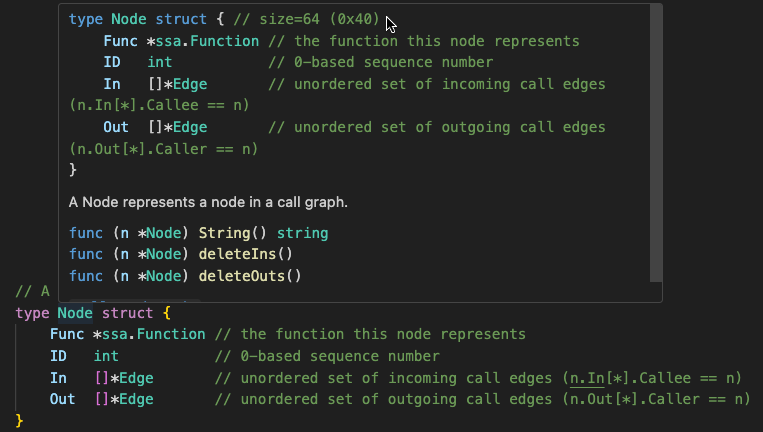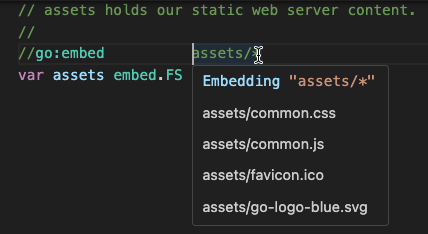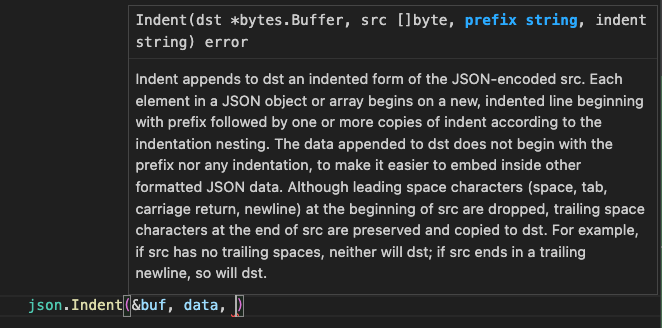Gopls: Passive features
This page documents the fundamental LSP features of gopls that may be described as “passive”, since many editors use them to continuously provide information about your source files without requiring any special action.
See also Code Lenses, some of which annotate your source code with additional information and may thus also be considered passive features.
Hover
The LSP textDocument/hover
query returns a description of the code currently under the cursor, such
as its name, kind, type, value (for a constant), abbreviated
declaration (for a type), doc comment (if any), and a link to the
symbol’s documentation on pkg.go.dev. The client may request either
plain text or Markdown.

Depending on the selection, the response may include additional information. For example, hovering over a type shows its declared methods, plus any methods promoted from embedded fields.
Doc links: A doc comment may refer to another symbol using square
brackets, for example [fmt.Printf]. Hovering over one of these
doc links reveals
information about the referenced symbol.

Struct size/offset info: for declarations of struct types, hovering over the name reveals the struct’s size in bytes:

And hovering over each field name shows the size and offset of that field:

This information may be useful when optimizing the layout of your data structures, or when reading assembly files or stack traces that refer to each field by its cryptic byte offset.
In addition, Hover reports:
- the struct’s size class, which is the number of bytes actually allocated by the Go runtime for a single object of this type; and
- the percentage of wasted space due to suboptimal ordering of struct fields, if this figure is 20% or higher:

In the struct above, alignment rules require each of the two boolean fields (1 byte) to occupy a complete word (8 bytes), leading to (7 + 7) / (3 * 8) = 58% waste. Placing the two booleans together would save a word. (In most structures clarity is more important than compactness, so you should reorder fields to save space only in data structures that have been shown by profiling to be very frequently allocated.)
Embed directives: hovering over the file name pattern in
//go:embed directive, for example
*.html, reveals the list of file names to which the wildcard
expands.

Linkname directives: a //go:linkname directive creates a linker-level alias for another symbol.
Hovering over the directive shows information about the other symbol.

The hover information for symbols from the standard library added after Go 1.0 states the Go release that added the symbol.
Settings:
- The
hoverKindsetting controls the verbosity of documentation. - The
linkTargetsetting specifies the base URI for Go package links
Caveats:
- It is an unfortunate limitation of the LSP that a
Hoverrequest currently includes only a position but not a selection, as this means it is impossible to request information about the type and methods of, say, thef(x)portion of the larger expressionf(x).y. Please upvote microsoft/language-server-protocol#1466 if you would like to see this addressed.
Client support:
- VS Code: enabled by default. Displays rendered Markdown in a panel near the cursor.
- Emacs + eglot: enabled by default. Displays a one-line summary in the echo area.
- Vim + coc.nvim: ??
- CLI:
gopls definition file.go:#start-#endincludes information from a Hover query.
Signature Help
The LSP textDocument/signatureHelp
query returns information about the innermost function call enclosing
the cursor or selection, including the signature of the function and
the names, types, and documentation of each parameter.
Clients may provide this information to help remind the user of the purpose of each parameter and their order, while reading or editing a function call.

Call parens are not necessary if the cursor is within an identifier
that denotes a function or method. For example, Signature Help at
once.Do(initialize‸) will describe initialize, not once.Do.
Client support:
- VS Code: enabled by default. Also known as “parameter hints” in the IntelliSense settings. Displays signature and doc comment alongside Hover information.
- Emacs + eglot: enabled by default. Displays signature in the echo area.
- Vim + coc.nvim: ??
- CLI:
gopls signature file.go:#start-#end
Document Highlight
The LSP textDocument/documentHighlight
query reports a set of source ranges that should be highlighted based
on the current cursor position or selection, to emphasize the
relationship between them.
Each of the following parts of syntax forms a set so that if you select any one member, gopls will highlight the complete set:
- each identifier that refers to the same symbol (as in the screenshot below);
- a named result variable and all its corresponding operands of
returnstatements; - the
for,break, andcontinuetokens of the same loop; - the
switchandbreaktokens of the same switch statement; - the
funckeyword of a function and all of itsreturnstatements.
More than one of these rules may be activated by a single selection, for example, by an identifier that is also a return operand.
Different occurrences of the same identifier may be color-coded to distinguish “read” from “write” references to a given variable symbol.

Client support:
- VS Code: enabled by default. Triggered by cursor motion, or single click. (Note: double clicking activates a simple syntax-oblivious textual match.)
- Emacs + eglot: enabled by default. Triggered by cursor motion or selection.
- Vim + coc.nvim: ??
- CLI:
gopls signature file.go:#start-#end
Inlay Hint
The LSP textDocument/inlayHint
query returns a set of annotations to be spliced into the current file
that reveal implicit information.

Examples:
- In a function call
f(1, 2), hints provide the names of the parameters (parameterNames), as in the screenshot above. - In a call to a generic function, hints provide the type arguments
(
functionTypeParameters). - In an assignment
x, y = 1, 2, hints provide the types of the variables (assignVariableTypes). - In a struct literal such as
Point2D{1, 2}, hints provide the field names (compositeLiteralFields). - In a nested composite literal
T{{...}}, a hint provides the type of the inner literal,{...}(compositeLiteralTypes). - In a
for k, v := range x {}loop, hints provide the types of the variables k and v (rangeVariableTypes). - For a constant expression (perhaps using
iota), a hint provides its computed value (constantValues).
See Inlay hints for a complete list with examples.
Settings:
- The
hintssetting indicates the desired set of hints. To reduce distractions, its default value is empty. To enable hints, add one or more of the identifiers above to the hints map. For example:"hints": {"parameterNames": true}
Client support:
- VS Code: in addition to the
hintsconfiguration value, VS Code provides a graphical configuration menu (“Preferences: Open Settings (UI)” the search for “Go Inlay Hints”) for each supported kind of inlay hint. - Emacs + eglot: disabled by default. Needs
M-x eglot-inlay-hints-modeplus the configuration described here - Vim + coc.nvim: ??
- CLI: not supported
Semantic Tokens
The LSP textDocument/semanticTokens
query reports information about all the tokens in the current file, or
a portion of it.
The client may use this information to provide syntax highlighting
that conveys semantic distinctions between, for example, functions and
types, constants and variables, or library functions and built-ins.
The client must specify the sets of types and modifiers it is interested in.
Gopls reports the following token types:
"comment": a comment"function": a function"keyword": a keyword"label": a control label (not an LSP standard type)"macro": text/template tokens"method": a method"namespace": an imported package name"number": a numeric literal"operator": an operator"parameter": a parameter variable"string": a string literal"type": a type name (plus other uses)"typeParameter": a type parameter"variable": a var or const (seereadonlymodifier)
Gopls also reports the following standard modifiers:
"defaultLibrary": predeclared symbols"definition": the declaring identifier of a symbol"readonly": for constants
plus these non-standard modifiers each representing the top-level constructor of each symbols’s type:
"array""bool""chan""interface""map""number""pointer""signature""slice""string""struct"
Settings:
- The
semanticTokenssetting determines whether gopls responds to semantic token requests. This option allows users to disable semantic tokens even when their client provides no client-side control over the feature. Because gopls’ semantic-tokens algorithm depends on type checking, which adds a tangible latency, this feature is currently disabled by default to avoid any delay in syntax highlighting; see https://go.dev/issue/#45313, https://go.dev/issue/#47465. - The experimental
noSemanticStringandnoSemanticNumbersettings cause the server to exclude thestringandnumberkinds from the response, as some clients may do a more colorful job highlighting these tokens; see https://go.dev/issue/45753.
Client Support:
- VS Code: See Semantic Highlighting Guide.
- Emacs + eglot: Not supported; see joaotavora/eglot#615.
- Vim + coc.nvim: ??
- CLI:
gopls semtok file.go
Folding Range
The LSP textDocument/foldingRange
query reports the list of regions in the current file that may be
independently collapsed or expanded. For example, it may be convenient
to collapse large comments or functions when studying some code so
that more of it fits in a single screen.

The protocol allows clients to indicate whether they prefer fine-grained ranges such as matched pairs of brackets, or only ranges consisting of complete lines.
Client support:
- VS Code: displayed in left margin. Toggle the chevrons (
∨and>) to collapse or expand. - Emacs + eglot: not supported.
- Vim + coc.nvim: ??
- CLI:
gopls folding_ranges file.go
Document Link
The LSP textDocument/documentLink
query uses heuristics to extracts URLs from doc comments and string
literals in the current file so that the client can present them as
clickable links.

In addition to explicit URLs, gopls also turns string literals in import declarations into links to the pkg.go.dev documentation for the imported package.
Settings:
- The
importShortcutsetting determines what kind of link is returned for animportdeclaration. - The
linkTargetsetting specifies the base URI for Go package links.
Client support:
- VS Code: Hovering over a link displays a “Follow link (cmd+click)” popup.
- Emacs + eglot: not currently used.
- Vim + coc.nvim: ??
- CLI:
gopls links file.go
The source files for this documentation can be found beneath golang.org/x/tools/gopls/doc.